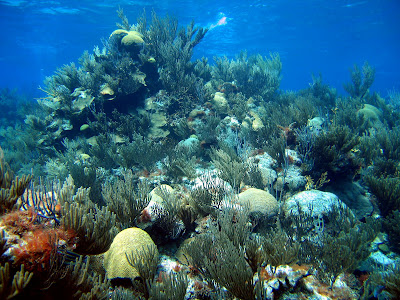BREAM - FY2009 Research Summary

Staff:
Chief Scientist: Thaddeus J. T. Murdoch, PhD
Laboratory Manager: Jessie Hallett, BSc
Dive Safety Officer: Robert Fisher, BFA, PADI dive instructor
Volunteers:
Ian Murdoch; Judie Clee; Jamie Rosser; Peter Hopkin
Interns 2009:
ACP: Brittany Huntington (RSMAS); Anke Moesinger (DISL)
OTEP: Katherine Yates (York)
GSEP: Claire Grenfell
Visiting Scientists
Matt Ajemian, Dauphin Island Sea Lab (BZS: Clee fellowship)
Brief Summary
Headed by Bermudian Dr. Thaddeus Murdoch, the BREAM: (Bermuda Reef Ecosystem Assessment and Mapping) Programme exists to produce and support multidisciplinary studies of Bermuda’s marine environment and to promote its care. Key to these endeavors is the use of rigorous assessment methodologies, data management, statistical analysis, and habitat mapping using geographic information systems (GIS).
BREAM projects in 2009 to date include:
· OTEP-funded assessment of most Buoyed Dive Site MPAs
· Coral transplantation from wreck near Heritage Wharf, Dockyard
· Baseline surveys around Dockyard prior to use of Heritage Wharf
· Coral husbandry apparatus developed and tested, for research and conservation actions
· A programme of ecological experiments on interactions between environmental conditions, fishes and corals and their effects of lagoonal reef health at Devil’s Flat
· Continuous water temperature assessment across Hamilton Harbour, Great and Little Sound, including during the 2009 summer fish mass mortality event
· provided research experience to US, UK and Bermudian summer interns
· took part in local and international scientific research meetings and publications
· advised the Bermuda Government Dept. Conservation Services and Dept. Environmental Protection in marine environmental issues
· supported international doctoral graduate students who:
- assessed the population ecology and feeding behaviour of eagle rays
- examined the ecology of patch reef corals and fishes
Comprehensive Summary
In April 2009, BREAM collaborated with the Department of Conservation Services on several occasions. BREAM helped transplant corals found on a derelict wreck adjacent to the new ship terminal of Heritage Wharf onto bare reef space left by the 2006 ship grounding. BREAM also conducted 12 baseline benthic surveys around Dockyard and Heritage Wharf. Later in the spring, BREAM received an OTEP grant to conduct benthic and fish surveys of all the buoyed MPA’s, as well as 30 foot, 60 foot, and 90 foot rim reef and terrace sites from 2009 to 2011. Spring also saw the completion of the BZS funded historical ecology project conducted by BREAM scientist Jessie Hallett on the two hundred year old Hurd survey.
During the summer, BREAM received assistance from four graduate students and interns. Most of the summer was spent on small-scale ecological studies in the vicinity of Devil’s Flat, where BREAM has been focusing research efforts on a long-term ecological assessment of the region. Physical data such as light and temperature were taken at multiple locations and depths, in order to quantify their effects on benthic community structure. A design for coral racks were developed and implemented, to be used for both coral husbandry and scientific research. In order to determine the optimal time for coral transplantation, coral recovery rates from experimentally-produced tissue lesions were assessed on a monthly basis since April 1st.. A pilot study was inititated into the effects of light on coral recruitment at the patch scale, by building a concrete block wall that had a south-face and a north-face. Five small concrete block artificial reefs were also built to examine seasonal rates of fish recruitment relative to natural patch reefs. The effects of parrotfish and damselfish on coral recruitment were also studied, and research regarding these interactions was initiated.
Throughout the year, temperature data was recorded at 10 different locations throughout the Great Sound. Temperature and light data was also recorded during the solstice and equinox periods during the year at a pinnacle reef adjacent to Devil’s Flat, to examine how light attenuation changes with depth and aspect on these reefs.
The remainder of the year 2009 BREAM focused on OTEP surveys of Buoyed Dive MPA sites. BREAM provided internship experience to Anke Moesinger through till the end of November to accomplish this task. During October, Matthew Ajemian will be in Bermuda continuing his studies of the ecology of the Eagle Ray population of Harrington Sound.
Winter 2010 BREAM focused on building a video drop camera, to survey reefs below 30-m depth, as part of the OTEP-funded project to describe forereef community structure around the Bermuda seamount. Murdoch and Hallett each presented at the Benthic Ecology Meeting in North Carolina.
Acknowledgements
BREAM is very grateful to accept support from the following funding agencies
• Department of Conservation Services http://www.conservation.bm
• Bermuda Zoological Society http://www.bamz.org
• Atlantic Conservation Partnership http://www.atlanticconservationpartnership.com/
• UK Govt – Foreign and Commonwealth Office – Overseas Territories Environmental Programme http://www.ukotcf.org/OTEP/
• National Atmospheric and Oceanic Administration: http://www.noaa.org
• Ernest Stempel Foundation

Comments